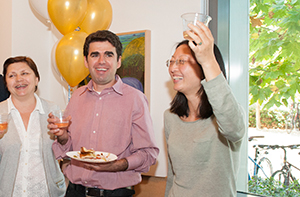October 7, 2013 - By Tracie White

Lu Chen, wife of Nobel prize winner Thomas Südhof, gathers with Sudhof's postdocs and grad students to celebrate the award. The lab members ate pizza and toasted Sudhof, who is attending a conference in Spain.
The news that Thomas Südhof had been awarded the Nobel prize trickled in early to members of his lab this morning: a scientist who couldn't sleep saw a news alert from the New York Times pop up on his cell phone about 3 a.m.; a husband heard about it from his wife who was scanning Facebook during breakfast. Others clicked on the radio, or read about it on the Stanford website.
But by noon, it was big news. A small crowd of scientists wandered out of their labs to take a champagne-and-pizza party break in a back room of the Lokey Stem Cell Research Building, where Südhof's lab is housed, on the medical school campus.
The celebration drew postdoctoral scholars and graduate students from several labs in the Department of Molecular and Cellular Physiology.
Champagne bottles popped, and the crowd cheered.
"This is for Tom in his absence," announced his wife, Lu Chen, PhD, associate professor of neurosurgery and of psychiatry and behavioral sciences, who also studies synapse function in the brain. Sudhof was in Spain giving a lecture at a conference, so he missed the party. "Just pretend I'm Tom. Congratulations to everyone, and let's try to win him another one."
The crowd of about 50 set down their paper plates of pizza and raised glasses of champagne in cheers.
Taulant Bacaj, PhD, from Albania, a postdoctoral scholar who has spent four years in Sudhof's lab, said the past two months have been particularly exciting with the announcement of the Lasker Basic Medical Research Award last month, new studies accepted by journals — and now a Nobel.
"Today makes it all even sweeter," said Bacaj who described Sudhof as "the hardest-working guy in the lab."
"Tom is very, very driven about finding the answer," Bacaj said. "There is nothing else he would rather be doing than to go to his office and think about data, and to talk to his postdocs about their findings. He's driven to pursue. He's a great role model for us, seeing that dedication to scientific questions."
Sudhof runs a lab of about 26 postdocs, with an additional three graduate students. Three of those postdocs eating pizza at a corner table — Patrick Rothwell, PhD, Theo Tsetsenis, PhD, and Louise Giam, PhD — voiced pride at being members of Sudhof's lab.
"He is very curious, but also rigorous," Giam said. "There's a lot of pressure to publish in science these days, but he wants most to get it right. That's what I mean by 'rigor.'"
"It's very impressive, how he manages to stay on top of a large lab with so many disciplines," said Rothwell, who is studying mice with autism-related mutations. "He's even-keeled and modest."
Within an hour, the partying was over, the champagne gone, the pizza boxes empty and the scientists began to trickle back to their labs, back to their work.
Bacaj paused before leaving to check on his mice and contemplate the significance of the day:
"Of course, everybody hopes to find the discovery that adds something important to human knowledge," he said. "Most people don't do it in order to one day get free pizza and a Nobel. It's that drive to find out how things work. That is its own reward."
About Stanford Medicine
Stanford Medicine is an integrated academic health system comprising the Stanford School of Medicine and adult and pediatric health care delivery systems. Together, they harness the full potential of biomedicine through collaborative research, education and clinical care for patients. For more information, please visit med.stanford.edu.